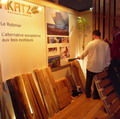www.acacia-robinia.co.uk
. |
. |
Bois
de construction |
Clayonnage |
. |
Jeux
extérieurs |
Bacs
de plantation |
Parquet |
Documentation |
Acacia
robinier.be markets in Belgium, UK, France,
derivatives of Robinia (decking, siding, tiles, paving stones, stakes
...).
Our direct links
with producers in France and Hungary, guarantee
excellent value for money.
Our expertise in
external works, listening to individuals, architects, landscapers, carpenters,
contractors, yard
has sharpened our perception of the specifics of the construction market
in the North.
Acacia robinier.be results from the need for alternatives to exotic woods and our desire to create a company committed to sustainable development.
delivery
possible full trucks. |
Robinia
pole sapwood free , gringed |
|
|
Last
deliveries... |
|
we send robinia playpark elements to Devon, Sussex, London UK, Ireland
|
New
playground opens at St John’s in Hoxton London |
| Project http://www.duncanandgrove.com fundraising Groundwork. New playground opens at St John’s in Hoxton after years of fundraising Youngsters
are over the moon with their new playground, which has replaced
old run-down play equipment closed off for years because of safety
fears. |
If you are a civil, building or landscaping contractors, we can advise and supply you with durable timber solutions .
At Akatz we focus
on understanding your project’s needs and then going about sourcing
it. We deliver directly to site, cut to your specification.
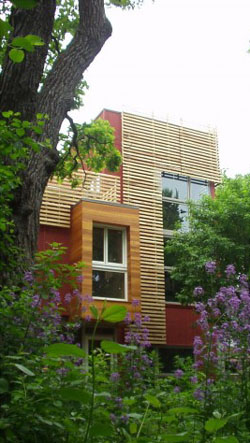
"The
black locust (Robinia pseudo acacia or) is a French and European timber.
It is naturally very resistant to biological attack.
It is a rare species native to be admitted for use in class
risks of employment, defined by European Standard EN 335-1and 2.
It can therefore be used for many outdoor uses without treatment
fungicide or insecticide.
Also interesting: the Acacia is derived from production
cultivated forest, sustainably managed and respecting the ecological balance.
The use of this wood was therefore only a low environmental impact.
There is an alternative to using exotic woods or woods treated
chemically.
Near the consumer environmental concerns, government
public anxious to present an image powerful and innovative teachers
wishing to promote works of wood European, will find
a response with the Locust. "
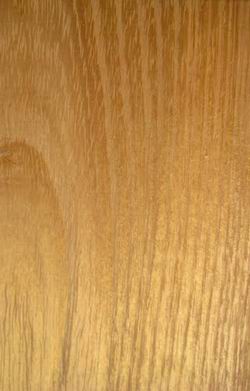
-
European Wood from forests managed sustainably grown and
- A low environmental impact
- Hard wood for outdoor use (Class 1)
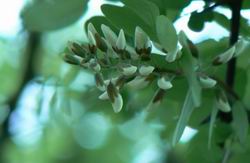
Finally
an alternative to Ipe - iroko - Itauba - bangkirai - teak - Garapa - Badi
and other exotic woods - autoclaved or treated high temperature.
Rebroadcast of the report of Special Envoy on illegal trade in exotic woods in Europe>>>
Comparatif
des caractéristiques du robinier, chêne, ipé et
bangkirai
issu de Forêt entreprise n°117
Fiche technique issue de:
woodforum.be/fr/essences/robinier
Derivatives of Robinia available:
Decking, joists,
battens, rafters, decks, terrace
Grating, floor tile, blocks Buzon, rooftop,
Wall cladding, facing,tavillons, shingles
Wood paving, curbs
Stakes, poles, beams
Fences, stakes, vegetable tray
Pontoons, held land, pond banks, wattle, piling, timber
Bench, garden furniture
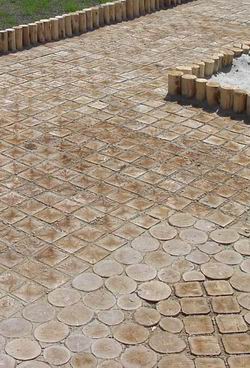
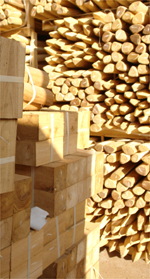
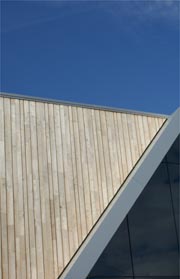
>>>
e-mail <<<
Decking board Robinia
to 57€ / m² excluding VAT
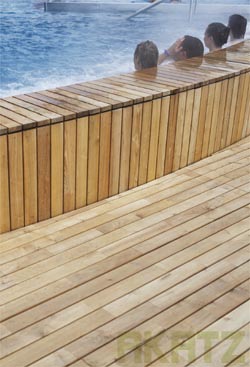
The natural durability of Robinia wood
Groepen van weerstand en duurzaamheid Groups of resistance and durability
De Robinia is een speciale plek tussen de Europese bomen vanwege de hoge
weerstand tegen abiotische en biotische milieu-invloeden. DIN-EN 350-2
lijsten bossen en classificeert ze volgens hun weerstand (tabel 1). The
Robinia has a special place among the European trees because of its high
resistance to abiotic and biotic environmental influences. DIN-EN 350-2
lists woods and classifies them according to their resistance (Table 1).
Robinia is de enige geteeld hout in Europa opgenomen in klasse 1. Robinia
is the only cultivated wood in Europe listed in class 1. Dat betekent
dat Robinia hout kan worden gebruikt in elke buitenruimte zonder dat een
speciale behandeling. That means that Robinia wood can be used in any
outdoor area without requiring special treatment. Dit showes dat Robinia
is een adequaat alternatief voor tropische houtsoorten. This showes that
Robinia is an adequate alternative to tropical woods.
1 1
2 2
3 3
4 4
5 5
Classificatie Classification
zeer duurzaam very durable
duurzaam durable
matig duurzaam moderate durable
minder duurzame less durable
niet duurzaam not durable
Typ van hout Typ of wood
robinia robinia
eik oak
kastanje chestnut
thuja thuja
douglas spar douglas fir
pijnboom pine
lariks larch
Red Oak sprunce red oak sprunce
beuken beech
populier poplar
Hieronder de plaatselijke weersomstandigheden producten die van de populier beginnen te rotten na 2 jaar, van beuken na 3 - 5 jaar, van as boom na zeven jaar, van lariks na 10 jaar en producten van de eik na 12 - 15 jaar. Below local weather conditions products made of the poplar are starting to rot after 2 years, of beech after 3 - 5 years, of ash tree after 7 years, of larch after 10 years and products of oak after 12 - 15 years.
Hout van de Robinia boom is vooruit met betrekking tot alle weerstand zaken. Wood of the Robinia tree is ahead of all concerning resistance matters. Zelfs in slechte kwaliteit producten van robinia hout, die in contact met de grond, zal duren outdoors over 20 jaar. Even in bad quality products of robinia wood, which are in contact with the ground, will last outdoors over 20 years. (GÖHRE 1952) (GÖHRE 1952)
Volgens uitgebreid onderzoek naar de levensduur van de masten, palen en constructie onderdelen van Robinia hout. According to extensive research on the lifespan of masts, poles and construction parts from Robinia wood.
(MOLNÁR 1988): (MOLNAR 1988):
buiten met contact met de grond 15 - 30 jaar outdoors with contact to
the ground 15 - 30 years
buiten zonder contact met de grond 60 - 80 jaar outdoors without contact
to the ground 60 - 80 years
onder water 500 jaar under water 500 years
onder droge omstandigheden 500 - 1000 years under dry conditions 500 -
1000 years
Redenen voor de hoge duurzaamheid van Robinia hout Reasons for the high
durability of Robinia wood
Inhoud en structuur ot het hout zijn de reden voor zijn hoge kwaliteit.
Contents and structure ot the wood are the reason for its high quality.
Robinia heeft ringvormige poriën die laten zien veel grote schepen
sloot bij elkaar in het begin van hout en donkere strepen van smalle cellen
in de latere hout. Robinia has ring shaped pores which show many wide
vessels closed together in the early wood and dark stripes from narrow
cells in the later wood. Robinia heeft coulored kernhout. Robinia has
coulored heartwood. De lichtere spinthout is voortdurend omgezet in het
donkere kernhout. The lighter sapwood is constantly converted into the
darker heartwood. Robinia bomen een van de kleinste proporties van spint
(1 cm sterk) en, daarvoor, bogen op 87% kernhout tot 30 cm in diameter
en 96% tot 90 cm in diameter. Robinia trees have one of the smallest proportions
of sapwood (1 cm strong) and, therefor, boast 87% heartwood up to 30 cm
in diameter and 96% up to 90 cm in diameter.
(Kucera 1997) (KUCERA 1997)
De belangrijkste feiten voor de hoge weerstand en duurzaamheid van Robinia hout zijn: The most important facts for the high resistance and durability of Robinia wood are:
vroege transformatie van de primaire cellen, waar de schepen zijn gesloten
en kan niet worden gebruikt om lucht of water meer vervoer, voorkomt dat
schimmels en insecten niet langer de mogelijkheid te voeden van het hout
early transformation of the primary cells where the vessels are closed
and can not be used to transport air or water anymore; prevents fungi
and insects no longer have the possibility to feed of the wood
bouw van kernhout begint al vroeg: binnen een paar jaar rubber en looistoffen
worden gevormd; daarom zeer weinig jonge hout is in het midden en de hoeveelheid
spint is laag building of heartwood starts early: within a few years rubber
and tanning agents are formed; therefor very little juvenile wood is in
the middle and the amount of sapwood is low
het kernhout ontwikkelt vergiftiging stoffen zo houtaantastende schimmels
en insecten worden gedood the heartwood develops poisoning substances
so wood destroying fungi and insects are killed
Technical Information
> Timber Species Database
> Robinia
Robinia pseudoacacia
Also known as: False acacia (UK), Black locust (USA)
Wood type Hardwood
Introduction A timber that is widely used in continental Europe for a
variety of purposes.
Environmental Not listed in CITES. Believed available from well-managed
sources. Check certification status with suppliers.
Distribution A native of North America, the tree has been introduced into
Europe, Asia and New Zealand and is supplied in commercial quantities
from Europe.
The Tree The trees can grow to a height of 24m to 27m. The bole is often
twisted or fluted with a diameter of 0.6m to 1m. In continental Europe
the trees are often coppiced, providing smaller, fast grown sections.
Older, larger trees often have a rotten heart.
The Timber The sapwood is narrow and clearly defined from the heartwood
which is greenish in colour when freshly cut, turning golden-brown after
drying. The timber is heavy and hard, although the texture is coarse due
to the contrast between porous earlywood and dense latewood. The grain
is usually straight.
Drying Slow to dry with a marked tendancy to distort.
Strength Comparable to oak in general strength properties and similar
to ash in toughness.
Working Qualities Medium - difficult - Due to the contrast in soft earlywood
and hard latewood bands. A good finish can be achieved but it is difficult
to nail.
Durability Durable
Treatability Extremely difficult
Density (mean, Kg/m³) 720 ( varies from 540 kg/m3 to 860 kg/m3)
Texture Coarse
Availability Limited availability at specialist timber merchant
Use(s) Decking, Flooring, Joinery - Exterior
Colour(s) Yellow brown (Golden brown)
Suppliers AKATZ uk
http://www.trada.co.uk/techinfo/tsg/view/142
Robinie - Falsch Acacia - (Robinia Pseudoacacia).
European wood that has exceptional good natural properties for usage outside especially when in direct contact with the soil or water. Durability aprox. 25 - 40 year when used in direct contact to the soil.
This durability is
achieved without any chemical treatment and merely due to the way the
tree grows and the closed cell structure with a heavy content of natural
tannic acid
For further info. concerning durability please see EN 350-2:1998 and the
publication from Dr. Molnár S., Dr. Bariska M.: Industrial wood
species in Hungary.
Advantages:
The Robinia pseudo acacia or Locust tree is cultivated as any other pine
or oak wood in the EU. The Robinia tree is resilient to all weather conditions.
For that reason it is usually employed where direct contact with the soil,
water or other similar conditions are needed. Durability EN I-II. Robinia
wood is stronger than oak. Robinia is environmentally friendly and naturally
impregnated.
Description: Posts, poles, sawn, geometrically round, sharpened, natural
or debarked
Use: Robinia tree is usually used to: vineyards, wharf buildings, structures,
gardens, fences, animal enclosures, children playgrounds, etc.
For info.: bois@acacia-robinier.be
- Weather resistant,
long lifetime outside
- Useful with direct soil contact
- Good mechanical results (strong)
- Nature friendly, no chemicals
Main product groups are:
- Poles (sharp, debarked,
sawn, edges broken)
- Outside decking, stepping elements, garden furniture
Robinia - Pseudoacacia:
Robinia is a plant genus in the papilonaceus family. It is known as well
by the name pseudoacacia ( false acacia) due to its similariry to the
genuine acacia, which mainly grows in tropical areas. They are however
two enterely different species.
Different names apart form Robinia are used to denominate the species:
Robinie, rubinia, locust tree, acacia, akacie, false acacia are some of
them.
The name Robinia has its origen in Henry IV´s gardener Jean Robin
(Head of the Botanical Garden in Paris) who in 1601 introduced the tree
in Europe from the North American continent.
Robinia was tested, as many other tree species, in forest exploitation.
Now, 400 years after, the species is widespread in the woods of Southern
and Eastern Europe. Robinia (rubinia) is said to be one of the most abundant
hardwood species after Eucaliptos and Poplar. It is in no way a threatened
species. See also English info.: Robinia info. UK
Robinia - growth/appearance:
Robinie wood is characterized by a rapid growth during the early stages.
When the tree reaches 25-30 years of age its growth decreases considerably.
The species reaches rarely heights exceding 25 meters. Diameter growth
continues beyond that age, and there have been found examples of trees
with diameters ranging 120-130 cm.
The branches are smooth and have thorny shoots.
The leaves are pinnate with oval leaflets. Foliation occurs late in the
year. Flowering occurs shortly after. The flowers are white or pink, in
usually pendulous racemes. Its nectar is irrestible to bees.
The wood (xylem) has a narrow (5-10mm) white/yellowish sapwood (tree´s
aquifers). Kernel tree has a color ranging from golden to greenish. Its
cortex (bark) is thick and strong.
Inventories from 1978 indicate that in Europe alone approx. 860.000 ha.
were used for this particular species, with Hungary in the first place
with approx. 268.000 ha.
Following info. from The-Tree.org.uk: Friendly, enjoyable place for people who love trees.
Family: Leguminosae (Pea family), subfamily Papilionoideae
Synonyms: Black Locust, Locust Tree, Robinia.
Black Locust was one
of the earliest North American trees to have reached Europe. The first
known was in the garden of Jean Robin, herbalist to the King of France.
It was introduced to Britain in the 1630's and it has naturalised in some
places. It is locally common in the Southern half of England as a street,
garden and park tree.
Britain gained over a million Black Locust trees in the early 1800's after
William Cobbett, author of the English gardener, journalist and rural
reformer returned from a trip to the New Country full of missionary zeal
about the excellence of the tree.
Cobbett was
so impressed with Robinea pseudoacacia that he predicted that it would
replace all the British hardwoods then in cultivation. Quick growth was
seen as a huge advantage over the very slow growth of quality timber from
an Oak.
Maybe Cobbetts enthousiasm may also have been fired by the extensive nurseries
he had established at Kensington and Barnes to flood the country with
these miracle trees. Many people bought his trees at inflated prices,
but sadly their quality as a perfect timber tree left much to be desired,
as Cobbett had not selected his seed sources with enough care and most
of them became crooked trees stiff- limbed zig-zaggy branches. The bare
branches could be admired for much of the year, because as one critic
of the tree said: They are only in leaf for about a fortnight.....
That is of course massively exaggerated but it's true that Black Locust
does come into leaf relatively late and is early to shed its foliage again.
William Cobbett was
by no means the first Englishman to discover the special qualities of
the Black Locust tree nor the only one to feel passionately about it.
The debate about its virtues and 'vices' in Britain (and elsewhere) goes
a long way back. Here are just two other English examples:
The famous English arborist Evelyn wrote about the tree in his classic
work "Sylva", published in 1664: "By reason of its brittle
nature, it does not well resist . . . our high winds; and the roots, which
insinuate and run like liquorice under ground, are apt to emaciate the
soil, and, therefore, haply not so commendable in our gardens as they
would be agreeable for variety of walks and shade. They thrive well in
His Majesty's new plantation in St. James's Park."
Ebenezer Jessup wrote an article in 1791 in the Gentleman's Magazine proposing
that ten thousand acres in the New Forest and Forest of Dean should be
planted with False Acacia to be used for navy shipbuilding. He also stating
that he knew posts made of its wood to last from 80 to 100 years.
Name:
"Robinia" is named after Jean Robin, in whose garden the tree was first grown in Europe.
"Pseudoacacia"
means 'False Acacia' and comes from the similarities between this tree
and the Acacia's (also members of the Pea family) which grow in Australia,
Africa, etc. To add to the confusion we call these real Acacia'a: Mimosa
or Wattle.
The actual word 'Acacia' derives from the Greek 'akis' meaning 'thorn'.
'Locust Tree' is a
name given to Robinia pseudoacacia (and its close relative Gleditsia triacanthos)
by some of the 17th century religious immigrants to America.
The Bible tells the story of how John the Baptist was kept alive in the
wilderness by eating 'locusts', which were not the insects, but the pods
of the Carob tree, which have some resemblance to the beasties. Carob
(Ceratonia siliqua) is an evergreen member of the Pea family, which grows
in hot dry areas and whose lavender-brown pods contain 10-16 glossy seeds
in a sweet pulp, which is very nutritious and tastes rather like chocolate!
When the Christian immigrants discovered Robinia and Gleditsia, who were
also members of the pea family and which has roughly similar pods, they
were called the "Black Locust" and the "Honey Locust"
respectively.
Habitat: Originally
native in the Appalachian Mountains (below 3500 feet) from central Pennsylvania
south to northern Alabama and Georgia in the East USA and also in southern
Missouri, north and west central Arkansas, eastern Oklahoma, southern
Illinois and southwestern Indiana.
An excellent reputation for good hard wood, combined with fast growth
and its popularity as a street tree has contributed to the spread of the
Black Locust to be cultivated throughout the world. It seems to thrive
on a wide range of soils and can cope with much drier climates than it
finds in the regions of its origin. It has been planted and is naturalized
north to Nova Scotia, Quebec and Ontario, it grows well in places like
Cyprus and Israel and it has been widely used as a forest tree in East
European countries. It has also been grown extensively in China, Korea,
the Himalayas and New Zealand. As if this huge range from temperate to
subtropical does not suffice, the tree has also been grown in some of
the upper cooler regions of tropical Java!
Characteristics:
When forest-grown, False Acacia can produce clear, straight trunks, but
depending on inherited tendencies it may tend to fork and be crooked when
grown in an open position.
The tree has sharp spines, which are found at the nodes of young branches
but are rare on mature wood.
The brown or grey bark is furrowed and these grooves are often twisted.
The foliage is light green or yellowish-green with alternate feathery
(pinnate) leaves. Each leaf consists of a midrib with 4 to 9 pairs of
small leaflets (oval/ovate and 2.5 to 5 cm long) and a leaflet at the
tip.
A few weeks after the leaves first appear the pea-like hermaphrodite flowers
come out in May/June. They have a sweet vanilla-like scent, are creamy
white and hang in drooping clusters.
After being fertilised by insects, especially bees, the fruits develop
into smooth brown flattish pods (10-15cm) with 4-8 black seeds. They ripen
in September/October and remain on the tree until they split into two
and are carried off (with seeds attached) by the wind in winter and early
spring.
False Acacia does
not have wide spreading limbs, but relatively short branches and aren't
prone to break of their own weight or during storms. However the tree
as a whole may be susceptible to storms, as it does not have a taproot
and the hard wood can be brittle. Otherwise it is a long-lived tree.
It can grow to 25 meters with a diameter of about 90 cm. There is a champion
tree in Kew gardens that is 27 m high and has a diameter of 112 cm (measured
in 2001)
Many varieties and
cultivars of Black Locust has been bred during the several hundred years
of cultivating this tree. These include both ornamental varieties, suitable
as a street or garden tree and strains, which are more suitable for forestry.
The huge worldwide interest in this tree will no doubt produce many more.
In the USA research is taking place to find strains which are resistant
to borer insects, such as the locust stem borer, Megacyllene robinae,
which does a lot of damage, because its larval tunnels makes the wood
unusable and weaken the tree, which can then become very prone to wind
damage. Heart rot (Fomes rimosus) can often follows borer attack, especially
in older trees.
These pests are generally not present in other countries where the tree
has been naturalised or planted.
Cultivation:
Most natural reproduction of False Acacia/Black Locust is vegetative by
means of root suckering and stump sprouting. Propagation is usually by
seed or suckers.
Seed production can be variable. Trees will probably start to bear fruit
from about 3-6 years onwards, although there have been incidences of a
tree starting to fruit only at 60 years old. The best seed crop are found
between 15 and 40 years old and years of heavy fruiting and then a much
lighter crop are common. The fragrant flowers (10-25 cm long hanging racemes)
appear in May and June soon after the leaves. In Britain the tree often
fails to flower. Pollination is by insects, especially bees. 4 to 8 seeds
grow in a pod and ripen in September/October. These pods open on the tree
during the Winter and early Spring. Nevertheless there are very few seedlings.
The seeds have hard, impermeable outer coats, which are relatively impervious
to water. The seeds must therefore be softened by treatment with sulfuric
acid, soaking in hot water, or scarification. Due to the hard coats the
seeds stay viable for many years. A kilo will contain roughly 35,000-50,000
seeds.
(I had a batch of seeds one year, which I soaked in hot water and had
reasonable germination. Once germinated, the seedlings were very easy
to grow - webmother)
Early growth is very speedy and can be from 45 cm to 120cm a year, depending
on the site.
Black locust can be
vegetatively propagated from shoot and root cuttings, but success rates
vary. Grafted or rooted shoot sections produce lateral growth, while sprouts
from roots grow upright (Prentice 1987).
You can try hardwood cuttings (15-30 cm long and 1-2 cm diameter) collected
in winter or early spring. Treatment with indole acetic acid improves
rooting.
The tree likes well-drained
soil and full sun, but will grow in almost any soil. However, it will
not grow so well in competition with other trees, vines, or grasses, nor
will it grow well on very poorly drained, heavy-textured soils. Nevertheless
it has been said that it will tolerate soils that are to poor, compact
or dry and hot for any other tree and therefore it has been recommended
for use as a pioneer tree on coal tips and as a street tree
Fast grower: 40 feet in 20 years. Strong root system. Young trees has
been used to contain embankments and hillsides. Resistant to pollution
and dryness.
People have noticed,
that if the roots are damaged for some reason, e.g. through ploughing
or digging, the growth of root suckers will increase.
In the right conditions, it can spread fast via suckering and may become
a pest.
Black locust is a legume. Nitrogen-fixing bacteria associated with nodules
on the roots increase nitrogen content of the soil in which the tree grows.
The tree is said to be resistant to honey fungus.
Wood:
The light to dark brown wood is beautiful, strong, hard and highly resistant
to rot. I have heard reports of Locust fence posts in Virginia that have
stood in the ground for at least 70 years, some say that posts have been
able to functional for an amazing 100 years. A tree that produces such
wood is of course a valuable asset. Think for example of vineyards, who
need lots of stakes to hold up their valuable vines. Its is a lot of work
to replace the vine supports, but using Robinia stakes one could rest
assured in the knowledge that the vine supports takes will not need replacing
for the next 50 years.
The wood has a specific gravity of 0.68 and has the lowest shrinkage value
of the domestic woods produced in the USA.
It should be pointed out that the finest wood comes from the poorest soils,
because the slower growth makes the wood denser and harder. Faster growth
on fertile soils may produce wood that has larger cells and is relatively
brittle. I could be that the disagreement between people who think this
is a marvelous high-quality wood and those who think it is rather brittle,
may be due to soil and growth factors.
In the USA it has been used as a substitute for teak and it is used in
the making of a wide variety of products: paneling, siding, flooring,
furniture, boat building, decking, vineyard or nursery props, fruit boxes,
pallets, and so on. It makes good wood pulp for paper and board, good
charcoal and a quality firewood (although it can sometimes flare up and/or
spark).
"In the past it has also been used for agricultural implements, tool
handles, shoe lasts, sports goods, dowels and pins for insulators on telephone
and telegraph wires, tree nails (wooden pins used to fasten the planks
to the ribs or timber of a ship), boat ribs, brackets, sleepers, and sills.
It is used also for light construction, gates, wagon hubs, cart wheels,
shipbuilding, furniture and turnery work. It is avoided for larger construction
purposes, because although it may be hard, it can also be brittle and
possibly lack 'bounce'. Some burrs of the trees provide attractive wood
for tabletops, and music cabinets."
Some American farmers use to like to grow a few Robinia's on the homestead
to provide for home timber needs, and it appears that Hungarian farmers
are continuing this practice. The tree has become one of Hungary's most
common forest trees. In 1991 nearly a fifth of its plantations consisted
of Locust. One of the foremost varieties used is the “Shipmast Locust”
originating from Long Island in New York State. This tree does not set
seed freely and Hungarian forest researchers have perfected the art of
raising large amounts of tall growing clones from tissue cultures.
Black Locust has one of the highest net photosynthetic rates among woody
plants and its biomass potential is considerable. In Korea the tree is
used in fuel-wood plantations. The tree can be coppiced or lopped annually
for fuel.
CAUTION: Toxicity!
It is quite confusing to establish the exact danger posed by the toxicity
of the Black Locust. The foliage has been used as animal fodder in places
like the Himalayas and elsewhere. Some bits of the tree, such as seeds,
young pods and flowers have been used as human food (Please see below).
Considering the marvelous decay resistance of the wood to the degree that
it can act as a commercial wood preservative, it is obvious that the tree
produces chemicals which are toxic to some forms of life. The question
is what bits of the tree are toxic and which can be used for medicinal
purposes or food?
Mrs. Grieve (1931) reports that "Occasional cases of poisoning are
on record in which boys have chewed the bark and swallowed the juice:
the principal symptoms being dryness of the throat, burning pain in the
abdomen, dilation of the pupils, vertigo, and muscular twitches; excessive
quantities causing also weak and irregular heart action.
The root and bark have been used for their emetic and purgative properties,
but of course this is area that is unsuitable for self-medication, as
only someone with experience would know what the difference is between
a therapeutic dose and poisoning.
The leaves are used as fodder for the larger grazing animals, but seem
to be toxic to insects.
Seeds, young pods and flowers are said to be edible when cooked by humans.
Please remember that this website shares this information without being
able to take responsibility for its accuracy. We like to hear from anyone
who has experience with this tree and can give more information.
Other species too have these toxic and edible qualities sometimes. As
I'm writing this it occurs to me that Elder flowers are like the Robinia
flowers used in fritters and pancakes and that their leaves, like those
of Robinia have insecticidal properties.
Uses:
Erosion control and
reforestation on difficult sites
Black Locusts make ideal trees for colonizing degraded sites due to its
ability to cope with extremes such as drought, air pollutants, and high
light intensities and its nitrogen fixing ability, fast growth and dense
wood.
The trees have also been used for stabilising banks, because they have
the habit of 'suckering' extensively. This means that the underground
roots throw up shoots, which if allowed to do so, will grow into trees.
Cutting the tree down will cause increased suckering.
Soil improver
Its nitrogen fixing ability makes Black Locusts a good candidate for companion
planting schemes in agroforestry layouts. It can for example be intercropped
(in a socalled "Alley system") with vegetables. Strips of trees
improve the micro-climate, reduce weather damage to the crops growing
nearby and can also be harvested in their own right.
Experiments to mix Robinia with Conifers in forestry have not been very
successful, because the Locust grow faster than the Conifers. The shading
and over-topping led to a situation where the Conifers suffered a much
reduced growth and were not thriving.
Windbreak
The dense growth habit of the tree has made it popular as a fast growing
windbreak in some cases and it seems to be often used for this purpose
in China.
Wood preservative?
"Black locust wood is being studied to find the chemical basis for
its remarkable decay resistance. High flavonoid concentrations (6% of
dry weight) are important, especially the constituents robinetin and dihydrorobinetin
(Smith et al. 1989). When impregnated into easily decayed woods, heartwood
extracts have raised decay resistance to a level equivalent to that attained
by commercial wood preservatives (Smith et al. 1989)."
Resistance to rot may be due to the wood containing 4% taxifolin, an isomer
of dihydroquercetin, or dihydrorobinetin, a growth-inhibitor of wood-destroying
fungi. The flower is said to contain the antitumor compound benzoaldehyde.
Some have classified the honey as toxic, others as the best of honeys
(Shah, 1972).
Oil
The Plants For A Future (PFAF) database gives the following information:
A drying oil is obtained from the seed.
An essential oil is obtained from the flowers. Highly valued, it is used
in perfumery
Dyes
A yellow dye is obtained from the bark
"Robinetin is a strong dyestuff yielding with different mordants
different shades similar to those obtained with fisetin, quercetin, and
myricetin; with aluminum mordant, it dyes cotton to a brown-orange shade"(C.S.I.R.,
1948–1976).
Tannin
The bark contains tannin, but not in any huge quantities and probably
not in sufficient quantity for utilization. On a 10% moisture basis, the
bark contains 7.2% tannin and the heartwood of young trees 5.7%.
Fibre
The bark has been used to make paper and can be used as a substitute for
silk and wool.
Because of the fast growth of the tree, it has great potential as biomass
and thus also as a source of paper pulp.
Natural insecticide?
The leaves are said to be insecticidal. However I do not know in what
form and would like to hear from anyone with more information. I have
read that he bruised foliage mixed with sugar will attract and kill flies.
Would love to hear from anyone who has tried this to see how well it works?
Another possibility could be that a strong brew is made from the leaves
and used for spraying?
It is interesting in this context that the leaf juice is also known to
inhibit viruses.
Honey Producer
Bees love the flowers! In areas where the tree flowers freely, it is highly
esteemed for the quality of the honey that the bees produce from it and
some say this is the worlds finest honey. The Robinia honey from the Danube
basin is known as Acacia honey and commands a higher price than any other
honey. Research to develop varieties which flower later and have high
nectar sugar content has been taking place in Hungary and the USA.
Fodder tree
Black Locust can be used a fodder tree and appears to be important for
this use in the Himalayas, where the tree has naturalised. It is also
used for this purpose in Korea and Bulgaria.
With the input of human energy a very efficient use of sparse land resources
can potentially be achieved, especially for subsistence farmers. A tree
is capable of producing far more greenery in a given spot, than this same
amount of land would have produced as conventional grazing, even if only
a quarter of its leaves would be eaten. Branches out of reach of life
stock are cut whenever required and the remaining wood is used as fuel.
Ground black locust tops including woody stems have a good crude protein
content of 23-24% and 7% lignin, and 4.2 kcal/g. Ruminal digestion by
cattle was also equivalent (Baertsche et al. 1986)
There may be some problems with the tannins and lectin proteins found
in leaves and inner bark, because they can interfere with digestion in
ruminants and in nonruminants. To much tannin has the effect of "leatherising"
the mucous coating of the digestive tract by coagulating the protein found
in the mucous. (It is of course for this that tannins have been used to
create durable leather from animal skins). In the alimentary canal this
have the effect that nutrients do not absorbed into the bloodstream of
the gut, but simply pass out the other end.
Since tannin levels are high in young leaves but decrease as leaves mature,
it is therefore advisable to lop only the more mature leaves as fodder.
The high nutritional value of the leaves (similar to alfalfa (Medicago
sativa L.) makes it feasible to consider commercial feed production, as
silage, hay or leaf meal.
The tree has probably developed its thorns to protect itself from browsing
animals. No doubt people will try to find varieties which are thornless.
There have been trials in the USA to grow this plant as a conventional
foddercrop at planting densities from 40,000 to 1,000,000 per hectare.
Conventional hay-cutting equipment was used for harvesting and it was
noticed that the stipular thorns on new growth do not become sharp until
the stem turns woody
Human Food (Please
read Caution)
The seeds, young pods and flowers are edible when cooked. The seeds are
said to lose their acid taste after boiling.
The creamy white flower racemes have been used to make delicious fritters.
Similarly they can be added to pancakes. Other uses of the flowers are
as an addition to jam or for making a pleasant tea.
The PFAF database mentions that Piperonal is extracted from the plant,
and that it is used as a vanilla substitute. Alas there is no more information
available to me than these bare facts, but I wonder if the piperonal is
extracted from the flowers, as they have a lovely vanilla aroma. Therefore
the piperonal may be the name for an essential oil from the flowers that
has reportedly been used as a spice, in sherberts and toilet waters.
I have read that a strong, narcotic and intoxicating drink is made from
the skin of the fruit, but I have no details about doses and effect.
Another reported usage that definitely requires further credentials is
that Robinia can serve as a vegetable rennet. The only additional information
I can give is a statement from Mrs. Grieve's Modern Herbal, which says
that: "The inner bark contains a poisonous proteid substance, Robin,
which possesses strong emetic and purgative properties. It is capable
of coagulating the casein of milk and of clotting the red corpuscles of
certain animals."
I certainly would not recommend this use unless more information becomes
available.
Medicinal (Please
read Caution)
The living tradition of the medicinal use of this tree has largely been
lost, or at least I have not found examples of contemporary use. All the
same, Black Locust is reported to have a long catalogue of medicinal qualities,
which I have listed below with an explanation of the term.
- Anti-spasmodic -
Helps to relieve muscular spasms and cramps.
- Anti-viral - Helps the body fight viral diseases
- Astringent - Tightens and tones bodily tissues and reduces the flow
of secretions and discharges of blood, mucus, diarrhoea etc. Cholagogue
- Increases the flow of bile and its discharge from the body, which often
also has as it result a slight improvement of liver function and digestion.
Diuretic - Promotes the flow of urine.
- Aromatic - Has an agreeable odour and stimulant qualities.
- Emetic - Induces vomiting (a useful 'therapy' in a few circumstances).
- Emollient - Softens (e.g. the skin) and soothes inflamed or irritated
surfaces (internally and externally).
- Febrifuge - Reduces fevers.
- Laxative - Relieves constipation and stimulates bowel movements in a
fairly gentle manner.
- Narcotic - In therapeutic doses induces drowsiness, reduces sensibility,
relieves pain, induces sleep and gives an artificial sense of well-being.
In larger doses it causes stupor, coma and convulsions.
- POISON - See above.
- Protisticidal - kills a group of organisms which includes the unicellular
plants and animals and, on some classifications, the viruses.
- Purgative - Relieves constipation and stimulates bowel movements in
a fairly drastic manner.
- Sedative - Gently calms, reducing nervousness, distress and irritation.
- Tonic - Improves the tone of a body organ and/or the general condition
of a patient and so improves general health. Slower acting than a stimulant,
it brings steady improvement.
The following are the main remnants of knowledge left to us that give us some insight in how the above properties were used in practice (sourced mostly from the PFAF database)
- Cherokee used the
plant as an emetic and for toothache
- Black locust has been a folk remedy for dyspepsia and spasms in the
USA (Duke and Wain, 1981)
- The flowers are antispasmodic, aromatic, diuretic, emollient and laxative
- The flowers are cooked and eaten for the treatment of eye ailments
- The inner bark and the root bark are emetic, purgative and tonic
- The root bark has been chewed to induce vomiting
- The root bark has been held in the mouth to allay toothache
- The leaves are cholagogue and emetic
- The leaf juice inhibits viruses
- A tea made from the flowers was tried for headaches, stomach pains,
and nausea
- black locust blossoms steeped in wine were used to treat anemia.
Where to buy robinia in the UK or Ireland?
What is the price of robinia ?
Contact : bois@acacia-robinier.be
Alexandre
Vidos
Mobil : 0032 472 84 24 00
Fax : 0032 69 65 94 41


